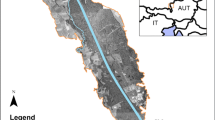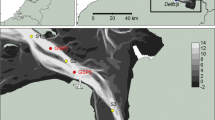Abstract
Bayesian methods have recently been applied to one-dimensional sediment transport models to assess the uncertainty in model predictions due to uncertainty in the parameter values. However, these approaches neglect any uncertainties in the model inputs, which might play a substantial role. The objective of this research is to include uncertainties in sediment transport model inputs and evaluate their contributions to the overall uncertainty in the model predictions. To accomplish this goal, simple error models are developed for the input data and integrated into an existing Bayesian method. Five types of input data are considered: input discharges, rating curves, vertical and horizontal distances in cross-sections, and benchmark elevations that define the longitudinal profile of the reach. The input errors are modeled using Gaussian distributions, and the means and standard deviations are treated as uncertain parameters that are estimated within the Bayesian framework. The Bayesian approach is coupled to the Sedimentation and River Hydraulics-One Dimension (SRH-1D) model and used to simulate a 23-km reach of the Tachia River in Taiwan. When input uncertainties are included, the prediction ranges change substantially and cover more of the available observations, which suggests the uncertainty is better represented when input errors are considered. The results also indicate that the errors in the benchmark elevations have the largest impact on the uncertainty of the predictions among those considered.








Similar content being viewed by others
References
Ajami NK, Duan Q, Sorooshian S (2007) An integrated hydrologic Bayesian multimodel combination framework: confronting input, parameter, and model structural uncertainty in hydrologic prediction. Water Resour Res 43:W01403. https://doi.org/10.1029/2005WR004745
Bertin X, Fortunato AB, Oliveira A (2007) Sensitivity analysis of a morphodynamic modeling system applied to a Portuguese tidal inlet. In: Proceedings of 5th IAHR symposium on river, coastal, and estuarine morphodynamics, pp 11–17
Box GEP, Tiao GC (1973) Bayesian inference in statistical analyses. Addison-Wesley-Longman, Reading
Bunte K, Abt SR (2005) Effect of sampling time on measured gravel bed load transport rates in a coarse-bedded stream. Water Resour Res 41:W11405. https://doi.org/10.1029/2004WR003880
Camenen B, Larroudé P (2003) Comparison of sediment transport formulae for the coastal environment. Coast Eng 48(2):111–132
Chang CH, Yang JC, Tung YK (1993) Sensitivity and uncertainty analysis of a sediment transport model: a global approach. Stoch Hydrol Hydraul 7(4):299–314
Cho E, Arhonditsis GB, Khim J, Chung S, Heo T (2016) Modeling metal-sediment interaction processes: parameter sensitivity assessment and uncertainty analysis. Environ Model Softw 80:159–174
Chow VT (1959) Open channel hydraulics. McGraw-Hill, New York
Christensen R, Johnson W, Branscum A, Hanson TE (2011) Bayesian ideas and data analysis: an introduction for scientists and statisticians. CRC Press, Boca Raton
Clément P, Piégay H (2003) Statistics and fluvial geomorphology. In: Kondolf GM, Piégay H (eds) tools in fluvial geomorphology. Wiley, Chichester, pp 597–630
Corazza MZ, Abrao T, Lepri FG, Gimenez SM, Oliveira E, Santos MJ (2012) Monte Carlo method applied to modeling copper transport in river sediments. Stoch Environ Res Risk Assess 26(8):1063–1079
Cui Y, Parker G (1998) The arrested gravel front: stable gravel-sand transitions in rivers Part 2: general numerical solution. J Hydraul Res 36(2):159–182
Davies AG, van Rijn LC, Damgaard JS, van de Graaff J, Ribberink JS (2002) Intercomparison of research and practical sand transport models. Coast Eng 46(1):1–23
De Risi R, Goda K, Mori N, Yasuda T (2017) Bayesian tsunami fragility modeling considering input data uncertainty. Stoch Environ Res Risk Assess 31(5):1253–1269
Frings RM, Schüttrumpf H, Vollmer S (2011) Verification of porosity predictors for fluvial sand-gravel deposits. Water Resour Res 47:W07525. https://doi.org/10.1029/2010WR009690
Gaeuman D, Andrews ED, Krause A, Smith W (2009) Predicting fractional bed load transport rates: application of the Wilcock–Crowe equations to a regulated gravel bed river. Water Resour Res 45:W06409. https://doi.org/10.1029/2008WR007320
Gelman A, Rubin DB (1992) Inference from iterative simulation using multiple sequences. Stat Sci 7:457–472
Green PJ (2001) A primer on Markov chain Monte Carlo. In: Barndorff-Nielsen OE, Cox DR, Klüppelberg C (eds) Complex stochastic systems. Chapman & Hall/CRC, Boca Raton, pp 1–62
Greimann BP, Lai Y, Huang JV (2008) Two-dimensional total sediment load model equations. J Hydraul Eng 134(8):1142–1146
Huang JV, Greimann BP (2013) User’s manual for SRH-1D 3.0. Bureau of Reclamation, U.S. Department of the Interior, Denver
Huard D, Mailhot A (2006) A Bayesian perspective on input uncertainty in model calibration: application to hydrological model “abc”. Water Resour Res 42:W07416. https://doi.org/10.1029/2005WR004661
Kanso A, Chebbo G, Tassin B (2005) Bayesian analysis for erosion modelling of sediments in combined sewer systems. Water Sci Technol 52(5):135–142
Kavetski D, Franks SW, Kuczera G (2002) Confronting input uncertainty in environmental modelling. In: Duan Q, Gupta HV, Sorooshian S, Rousseau AN, Turcotte R (eds) Calibration of watershed models. American Geophysical Union, Washington. https://doi.org/10.1029/WS006p0049
Lai Y, Greimann BP (2010) SRH model applications and progress report on bank erosion and turbidity current models. Bureau of Reclamation, Department of the Interior, Denver
Laloy E, Vrugt JA (2012) High-dimensional posterior exploration of hydrologic models using multiple-try DREAM (ZS) and high-performance computing. Water Resour Res 48:W01526. https://doi.org/10.1029/2011WR010608
Li L, Xu CY (2014) The comparison of sensitivity analysis of hydrological uncertainty estimates by GLUE and Bayesian method under the impact of precipitation errors. Stoch Environ Res Risk Assess 28(3):491–504
Limeneros JT (1970) Determination of the manning coefficient from measured bed roughness in natural channels. Geological Survey, U.S. Department of the Interior, Washington, DC
López R, Barragán J (2008) Equivalent roughness of gravel-bed rivers. J Hydraul Eng 134(6):847–851
McLean DG (1985) Sensitivity analysis of bedload equations. Proc Can Soc Civ Eng Ann Conf 1985:1–15
Metropolis N, Rosenbluth AW, Rosenbluth MN, Teller AH, Teller E (1953) Equation of state calculations by fast computing machines. J Chem Phys 21(6):1087–1092
Mueller ER, Pitlick J, Nelson JM (2005) Variation in the reference shields stress for bed load transport in gravel bed streams and rivers. Water Resour Res 41:W04006. https://doi.org/10.1029/2004WR003692
Nash JE, Sutcliffe JV (1970) River flow forecasting through conceptual models part I-A discussion of principles. J Hydrol 10(3):282–290
Nelson WB (1982) Applied life data analysis. Wiley, New York
Owen-Joyce SJ, Raymond LH (1996) An accounting system for water and consumptive use along the Colorado River, Hoover Dam to Mexico (No. 2407). Geological Survey, U.S. Department of the Interior, Denver
Pinto L, Fortunato AB, Freire P (2006) Sensitivity analysis of non-cohesive sediment transport formulae. Cont Shelf Res 26(15):1826–1839
Ruark MD, Niemann JD, Greimann BP, Arabi M (2011) Method for assessing impacts of parameter uncertainty in sediment transport modeling applications. J Hydraul Eng. https://doi.org/10.1061/(ASCE)HY.1943-7900.0000343
Sabatine SM, Niemann JD, Greimann BP (2015) Evaluation of parameter and model uncertainty in simple applications of a 1D sediment transport model. J Hydraul Eng. https://doi.org/10.1061/(ASCE)HY.1943-7900.0000992
Saltelli A, Andres TH, Homma T (1995) Sensitivity analysis of model output. Performance of the iterated fractional factorial design method. Comput Stat Data Anal 20:387–407
Sauer VB, Meyer RW (1992) Determination of error in individual discharge measurements. Geological Survey, U.S. Department of the Interior, Denver
Schmelter ML, Stevens DK (2013) Traditional and Bayesian statistical models in fluvial sediment transport. J Hydraul Eng. https://doi.org/10.1061/(ASCE)HY.1943-7900.0000672
Schmelter ML, Hooten MB, Stevens DK (2011) Bayesian sediment transport model for unisize bed load. Water Resour Res 47:W11514. https://doi.org/10.1029/2011WR010754
Schmelter ML, Erwin SO, Wilcock PR (2012) Accounting for uncertainty in cumulative sediment transport using Bayesian statistics. Geomorphology 175:1–13
Schmelter ML, Wilcock PR, Hooten MB, Stevens DK (2015) Multi-fraction Bayesian sediment transport model. J Mar Sci Eng 3(3):1066–1092
van Griensven A, Meixner T (2007) A global and efficient multi-objective auto-calibration and uncertainty estimation method for water quality catchment models. J Hydroinfor 9(4):277–291
Vrugt JA, Gupta HV, Bouten W, Sorooshian S (2003) A shuffled complex evolution metropolis algorithm for optimization and uncertainty assessment of hydrologic model parameters. Water Resour Res 39(8):1201. https://doi.org/10.1029/2002WR001642
Vrugt JA, Ter Braak CJ, Clark MP, Hyman JM, Robinson BA (2008) Treatment of input uncertainty in hydrologic modeling: doing hydrology backward with Markov chain Monte Carlo simulation. Water Resour Res. https://doi.org/10.1029/2007WR006720
Wilcock PR (2001) Toward a practical method for estimating sediment-transport rates in gravel-bed rivers. Earth Surf Process Landf 26(13):1395–1408
WRA (2008) Proposed engineering schemes for river stability control and energy dissipation for downstream of the Chichi Weir (in Chinese). 4th River Division, Water Resources Agency, Taiwan
Wu FC, Chen CC (2009) Bayesian updating of parameters for a sediment entrainment model via Markov chain Monte Carlo. J Hydraul Eng 135(1):22–37
Wu W, Wang SS, Jia Y (2000) Nonuniform sediment transport in alluvial rivers. J Hydraul Res 38(6):427–434
Ye M, Neuman SP, Meyer PD (2004) Maximum likelihood Bayesian averaging of spatial variability models in unsaturated fractured tuff. Water Resour Res 40:W05113. https://doi.org/10.1029/2003WR002557
Acknowledgements
The authors acknowledge the U.S. Bureau of Reclamation Science and Technology Program under Project 1596 for their financial support.
Author information
Authors and Affiliations
Corresponding author
Rights and permissions
About this article
Cite this article
Jung, J.Y., Niemann, J.D. & Greimann, B.P. Modeling input errors to improve uncertainty estimates for one-dimensional sediment transport models. Stoch Environ Res Risk Assess 32, 1817–1832 (2018). https://doi.org/10.1007/s00477-017-1495-8
Published:
Issue Date:
DOI: https://doi.org/10.1007/s00477-017-1495-8




